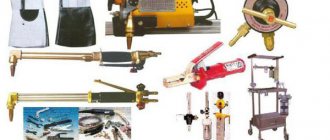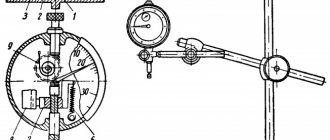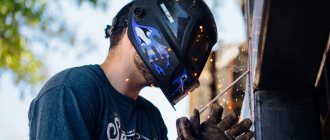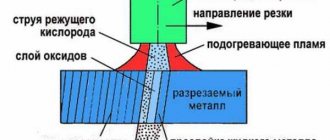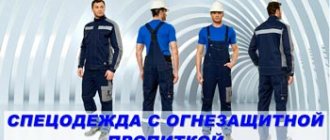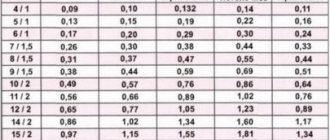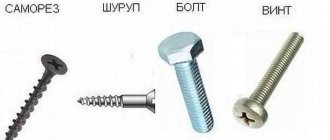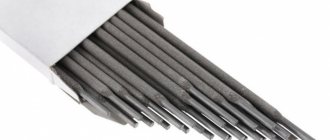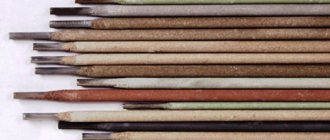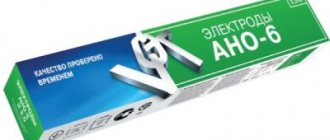Home / Consumables
Back
Reading time: 11 min
0
1964
Choosing the right materials for future welding does not seem to be such an easy task, especially for a novice master.
They can be classified indefinitely, using ever newer technologies.
The material provides a brief overview of welding wire, rods, solders with flux, conductive rods - electrodes, and how to choose the right ones.
- Welding Wire For Steel
- Aluminum, copper
- Cast iron
- Corrosion resistant
- Low-melting
- Active
- Brief typology of electrodes
Welding wire
Material for welding work is produced by many factories. It is produced in the form of wire in coils, rods, metal granules for acetylene and other types of gas welding.
The choice of additive is based on the thickness and chemical composition of the working parts; it must have the appropriate diameter and structure. If the elements being joined are 3.0 mm high, then the welding rod has the same diameter.
The situation with chemical composition indicators is somewhat more complicated. The connected elements can be steel, cast iron, non-ferrous metals or polymetallic.
For steel
The most widely used filler thread is wire for soldering various steels. The latter is produced using the same technology for both gas and arc welding.
Based on what has been said, it is difficult for a novice welder to get confused here. Of course, a chemical indicator of the articulated structures is still needed - low-carbon or with the addition of impurities - alloyed.
Particularly important welding operations are carried out using low-alloy thread.
The best quality welding or surfacing bead is obtained using manganese or silicon-manganese metal cord - wire.
These are represented by CB08ГС, CB08Г2C and CB10Г2. Their use produces a strong and reliable seam with high mechanical stability.
Low-alloy structures will require the use of the same wire, but containing chromium, which is expressed in high tensile strength. Alloy steels require a material comparable to them in terms of chemical composition.
Aluminum, copper
Aluminum thread, from its alloys, is determined by state standard number 787175, which corresponds to the following grades - CBAK5, CBA1, CBAMts.
The composition of the cord must be similar to the parts being connected. Copper and its connections are welded using wire type M1, MCp1 or filler rods M1p, M3p.
When connecting elements made of other non-ferrous metals or alloys, it is necessary to use the same composition of filler material as the working structures. Any brand of thread will work here.
Cast iron
Wire for connecting cast iron structures is specified by standard 267180, and comes in two grades - A and B. The first is used in the hot welding method, which is characterized by general heating of both parts.
The second is determined only by local heating.
The produced iron alloy rods with a high carbon concentration also have their own names - HCh1, HCh2. The listed rods are necessary for low-temperature welding of cast iron products.
XCh and BC class rods are used for surfacing coating of wear-resistant structures.
Cutting metal profiles
In the process of preparing parts for welding, metal cutting is one of the most important preparatory operations. As mentioned above, it will not be possible to adjust the profile to the required size without cutting.
This complex process is divided into two categories according to technology: mechanical and thermal. In the first case, this is a mechanical impact using various tools, which include manual and mechanical (electric or pneumatic). The first group includes a hacksaw, metal scissors, and a grinder. The second includes a guillotine, cutting machines of various models, presses, and so on.
Thermal cutting is essentially the melting of metal along applied markings. It can also be performed manually using an oxygen torch, plasma torch, arc welding and other methods, or using machines and devices in automatic or semi-automatic mode. Thermal technology for cutting metals is considered universal because it can be used to make cuts in different planes and in different directions (straight and curved).
Nuances of use
When using welding wire, you must pay attention to the following steps:
- clean from dirt, traces of oil, corrosion, and other deposits;
- form seams slowly and smoothly;
- prevent metal splashing during connection;
- Avoid the formation of pores, hot cracks, and slag inclusions.
The cooled seam bead should visually look uniform, without large roughness. During the welding process, it is necessary to prevent the penetration of refractory oxides into the weld pool.
The first ones take root in the welding zone with filler elements. Formed by the interaction of nitrogen and oxygen, they have an increased melting temperature compared to working parts. Getting them into the bath makes the seam of poor quality and heterogeneous.
Gas reducers
A welding material such as a reducer serves to relieve gas pressure from the cylinder and maintain the indicator at a constant level during the entire operating time, regardless of the decrease in the pressure of the substance in the cylinder. Gearboxes are produced in two-chamber and single-chamber types. The former work more productively, maintain constant pressure and do not freeze during prolonged use of gas mixtures. To supply gas to the burner, rubber hoses with fabric gaskets are used, which undergo preliminary testing for strength and pressure resistance, about which there are special documents. Hoses for oxygen and acetylene are used separately. To supply kerosene and gasoline, hoses made of material resistant to gasoline are used.
Filler rod
The execution of argon arc welding - TIG, will require additional materials that are not used in manual welding. They are a container with compressed gas, a profile long-length additive rod.
The latter is more often called a wire, which evenly fills the gap between the two elements being connected. Under the influence of high temperature, the rod melts, as a result of which it mixes with the metal of the working parts.
The rod appears to be the basis for the formation of the weld bead.
Assembly of parts
The last stage in a process such as preparing metal for welding is the assembly of parts, which will ensure their spatial arrangement, as well as the necessary clearances for welding. Very often, various templates, stands, clamping devices, jigs and other devices are used for assembly. Their main task is to join two workpieces in the required plane.
After which, tack welding is usually done along the connection line. This is when the seam is not completely welded, and the connection is made with short (often spot) welds. The length of such a seam is no more than 50 mm. The penetration is made to a third of the depth of the main root, the distance between them is 10-100 cm.
General information
A profile rod up to 1 m long is made of metal or synthetic polymer and is used as a filler component in welding to fill the groove between the joints being connected.
Used for argon arc welding, any gas welding. However, you should only cook with a rod whose composition is similar to the base material. Neglecting this rule will result in a seam of unsatisfactory quality.
The TIG filler rod is selected according to the characteristics of the base material. The first one must be clean and of correct shape, without the presence of traces of chemical destruction, oil stains, or dirt.
This will limit spattering of the rod during welding and excessive evaporation.
This type of filler material is produced in a length of 1000 mm, which facilitates its easy winding into a reel. However, such an implementation form may have an increased length.
Rods are used in welding all categories of metals, as well as polymers. A product that is not cleaned of dirt and oil may form a poor-quality roller.
Classification
There is no unified system for differentiating welding rods due to their wide variety. This is due to the fact that several dozen types of steel are smelted.
Based on this, rods are classified according to the type of work. Some are designed for soldering stainless steel parts, others - polymer ones.
Corrosion resistant
Used when working with steels that are resistant to corrosion. One of these types is stainless steel.
The resulting seam will be characterized by increased resistance to various types of corrosion - pitting and intercrystalline. This type of rod can be used for surfacing non-corroding working elements.
Aluminum
They form a high-quality seam when working with similar materials and their alloys. The rod includes additives of silicon, zirconium or magnesium. When exposed to high temperatures, the additive prevents the roller from cracking.
Basic materials for arc welding
When carrying out arc welding work, the use of suitable materials is required. They can be divided into two groups:
- compounds directly involved in the formation of metal;
- compounds not involved in this.
- Materials for arc welding involved in the formation of a metal joint (weld).
This group includes fluxes, rod electrodes (non-consumable and consumable), wire for the welding process. These materials are used in manual arc welding, for which electrodes are used, as well as in automatic/semi-automatic arc welding using fluxes and wire.
The production of welding electrode wire occurs in accordance with state standards. It is marked differently. Some of its types are used for the production of coated electrodes, others for gas arc welding or submerged arc welding.
The wire for the welding process is selected depending on the metal of the workpiece. Parts made of non-ferrous metals are subjected to arc welding using wire that matches the composition of the base metal of the workpiece. During the selection process, the wire is checked for compliance with specifications (technical conditions), as well as its cleanliness. Its surface should not have traces of oils, corrosion or impurities - anything that can reduce the quality of the weld, lead to the appearance of pores or foreign substances in it, which gradually destroy the joint during operation.
Fluxes are used for arc welding; they are divided into ceramic (unfused) and fused.
We recommend articles on metalworking
- Steel grades: classification and interpretation
- Aluminum grades and areas of their application
- Defects in metal products: causes and search methods
Unmelted fluxes are made from a special paste, which contains liquid glass and other well-ground components. The baking and drying that the paste goes through helps remove excess moisture from it. As a result, “grit” is formed.
This method has a significant drawback - during arc welding, these small granules are destroyed and disintegrate into their component parts, which then, when they get into the seam, help reduce its strength. Therefore, the use of ceramic fluxes is limited to certain types of arc welding. For example, where it is impossible to use fused fluxes or for surfacing.
Fused fluxes are made from ores and minerals of natural origin by smelting in furnaces (electric arc and glass melting).
Electrodes are rods with a special coating. Their length can reach up to 45 cm. Their scope of application is different, which is marked on each electrode (alphanumeric). It contains information about how, under what conditions and for what purposes it is best to use each electrode.
Let's consider the electrodes used to connect alloyed structural and carbon steels. There are several types of them, differing in the weld created and the mechanical characteristics of its metal.
Low-carbon steels of class C38/23 (StZ) are processed by manual arc welding using electrodes E46a, E46, E42a, E42. Low-alloy steels of classes C44/29 (09g2s, 10G2s, 109g2), as well as C46/33 (15khsnd, 14g2, 10g2s1d), are welded with electrodes E50a, E46, E50, E46a. This is an alphanumeric code, in which E is the electrode, and the numbers are the temporary resistance that occurs when the deposited metal is stretched (measured in kN/cm2).
The presence of the letter “a” indicates the high ductility properties of the deposited metal. Therefore, electrodes with codes E50a or E42a, as well as E46a are used to connect parts that often operate under vibration and dynamic loads. Electrode E60a is used when working with low-alloy steels of classes C60/45 or C52/40. E70 – with steels C70/60.
All types of electrodes have one, and sometimes several brands, differing in technological properties, coating (or rather, its composition), brand of rod, and metal properties. The coating (it is called coating) is divided into rutile, acid ore, and calcium fluoride.
Electrodes coated with ore-acid coating correspond to the brands TsM-8, OMM5, TsM7. They are designed to work with direct and alternating current in any position in space. The composition of the metal deposited by them is close to the composition of boiling steel. The disadvantages of such electrodes are the strong spattering of metal during arc welding, as well as the appearance of manganese compounds, which have an extremely harmful effect on people.
Electrodes of the brands UONI-13/55, SM-11, UONI-13/45 have calcium fluoride coating. They are used when operating with reverse polarity of DC current in any position. The deposited material has the properties of mild steel, as well as a good level of impact toughness, both at negative and positive temperatures.
These brands of electrodes are suitable for arc welding of sheet products of increased thickness, intended to work under pressure, and design elements of products that will work under dynamic influence.
- Materials used in arc welding that do not participate in the formation of weld metal.
Basically, these are protective gases such as helium, argon and others and their mixtures.
Helium and argon are inert gases with one atom, odorless and colorless.
Argon is heavier than air and prevents it from penetrating the weld pool. GOST 10157-79 contains the necessary information about argon, which is supplied for the welding process. It comes in two grades depending on the purpose of the gas and its percentage in the mixture. Argon is of the highest quality, which is used for arc welding of products made of non-ferrous metal. The first grade is used for steels. Special specifications (technical conditions) have mixtures of argon with other gases.
Helium is lighter than air, and significantly. According to GOST 20461-75, there is high-purity and technical helium.
Carbon dioxide or carbon dioxide is colorless and has a slight odor under normal conditions. Data on this gas is contained in GOST 8050-85. There are three types of gaseous substances: technical, welding and food - they differ in the content of the main component (gas).
The production and packaging of carbon dioxide differs in winter and summer. The volume of the cylinders into which the gas is poured is the same - 40 dm3. In winter, 30 dm3 or such an amount of liquid is placed in such a cylinder, from which 15,120 dm3 of gas will be obtained. In summer, the figure decreases - from 25 dm3 placed in a cylinder, 12,600 dm3 of gas is obtained. Cylinders for different brands of carbon dioxide are also different and can be used strictly in accordance with the categories of gas.
Purified hydrogen is a colorless and odorless gas, much lighter than air (14.5 times). Technical hydrogen, in accordance with GOST 3022-80, has three types. Used exclusively in mixtures.
Oxygen. There are three types of this gas, which are marked - 1, 2, 3, in accordance with GOST 5583-78. O2 is used as an additive to carbon dioxide or argon.
The most widely used mixtures are oxygen (O2), carbon dioxide (CO2) and argon (Ar). In the arc welding process, mixers are used to accurately measure the amount of different gases in the mixture: AKUP-1 - a mixture of carbon dioxide, argon and oxygen; UKP-1-71 – solution of oxygen with carbon dioxide; UKR-1-72 is a mixture of oxygen and carbon dioxide. Before the mixer, a dryer is installed in the equipment, which removes condensate and steam from the gas.
Variety of solders
Solder is a metal rod that, when melted, fills the free space between the parts being joined. The rod melts, mixing with the mating elements, or acts as the base metal.
Solders have different diameters and are made of tin, with inclusions of other metals. These can be lead, zinc or copper. They are characterized by melting indicators - easily (especially) fusible and refractory.
Low-melting
Such materials have found application in minor repairs, for example, of radio equipment, counting and computing machines, where the solder bath temperature should be in the range of 40-140 ° C.
An increase in the indicator threatens to overheat the board and neighboring parts. Additions of cadmium, bismuth or zinc increase the strength of the roller, cold resistance, and reduce electrical resistance and the temperature coefficient of linear expansion.
The work is carried out using an ordinary household soldering iron. When selecting solder for the electrical circuit of a radio or TV, you should choose a material with a melting point of up to 145°.
The boards are tinned with a different type of wire, which melts at the boiling point of water, which gives a high-quality result.
However, to repair a foreign computing device, you will need an alloy with an increased index - 200 ° C, which does not contain lead, which is hazardous to health.
Refractory
Such wire has a high operating temperature - more than 400°. It won’t be useful at home, but it will be just right for industrial enterprises.
Professional welding involves joining large parts, so copper, silver, nickel or magnesium additives are used here.
The increased diameter of the wire, which has not found its application in everyday life, successfully welds cast iron and brass parts that have high refractoriness.
Use of acetylene
Acetylene is a compound of oxygen and hydrogen. This flammable gas is in a gaseous state at normal temperatures. The colorless gas contains impurities of ammonia and hydrogen sulfide. The flammable component of the material is dangerous. Welding pressure of more than 1.5 kgf/cm2 or accelerated heating to 400 ºС is enough to cause an explosion. Gas is produced by an electric arc discharge, which promotes the separation of liquid flammable components or by the decomposition of calcium carbide under the influence of moisture.
Solder with flux
This welding material is determined by the presence of flux - a substance for removing oxide, which is located in the middle of the tubular solder.
A hollow rod filled with flux melts during operation and releases a mixture to perform a protective function. These are the solders “Kastolin 192” and “Brazetek” without cadmium.
The combination of two factors - practical and protective - makes them indispensable at home. There is no point in wasting time searching for and applying the substance to the workpiece.
However, compatibility is not the best option and is not able to provide the necessary protection to the solder bath. Separate use of alloy and antioxidant significantly improves soldering performance.
Safety water seals
The device for protecting the rubber pipeline and the gas generator from the return of backfire from the burner is called a shutter. The requirements for welding materials determine that the water seal is designed in such a way that it prevents the oxygen or acetylene mass in the hole of the torch or cutter from igniting. A water seal is necessarily included in the equipment; this is a fire safety requirement that must be met.
The valve is placed in the space between the cutter and the burner; according to the instructions, it is in good condition and is periodically filled with water to the required level. This device is the main one in the chain of welding equipment.
Flux categories
Flux is a substance or mixture intended for application to the soldering area to protect the base metal from oxidative processes. In terms of aesthetics, flux gives a smoother seam, and quality - increases the strength of the joint.
When using separately mentioned materials, pay attention to the fact that the flux must melt at a temperature lower than that of solder. This will be reflected in the quality of the roller result.
The industry produces fluxes of several categories - active and chemically passive.
Active
Chemically active flux contains acidic components. The latter are designed to destroy oxide deposits or traces of corrosion. Such chemicals can be hydrochloric acid, zinc dichloride, called soldering acid.
The surface of a part cleaned with acids from old soldering will not oxidize or corrode.
However, any substance contains an equal amount of positive and negative factors. Chemically active liquids, if used improperly, corrode metal and layered composite materials, often used in electronic circuits.
Accidental contact with acid on the skin causes severe burns, which makes it suitable for use only by specialists.
It is undesirable to use such chemicals in everyday household soldering. When connecting parts of electrical instruments and devices, it is also recommended to avoid such fluxes. This will prevent textolite boards from corroding.
Passive
Chemically inert substances are used in everyday life much more often than active ones. The former are not expressed by strong oxidative factors than the latter, which poses less of a danger for working with electronic boards and radioelements.
However, passive mixtures remove only superficial grease and dirt, without preventing parts from possible corrosion. Although this is not necessary to repair a radio, player or TV.
Rules for storing materials for arc welding
Materials for manual arc welding must be taken into account in compliance with the rules for placement in the warehouse. They are stored according to instructions RD 34.10.124-94. It establishes requirements for sorting, separate placement by brand, as well as mandatory storage in original packaging.
A warehouse or storeroom should be located in a closed room specially equipped for storing materials. Electrodes that have an additional coating, which are specially calcined, should be placed in rigid boxes or in drying cabinets. They must have a lid equipped with a seal. The storage temperature of materials should not fall below +15 °C.
Electrode production
Conducting rods and rods—electrodes—are produced by industrial enterprises in a fairly large assortment. However, they are united by one condition - they must be of high quality, made from pure materials.
This property allows you to achieve a stable arc during welding operations. A craftsman can form a high-quality weld with cheap consumables, but novice welders will need help choosing a rod manufacturer.
Brief typology of electrodes
Conductive rods cannot be classified only according to any parameter. The rods are divided according to the category of the material manufactured and its coating.
A brief typology of electrodes is as follows:
- Consumable metal electrodes - made of cast iron, steel, copper or aluminum. Each of them is designed for welding parts of a similar chemical structure. The melting electrode is both an anode and a cathode.
- Non-melting - the material is coal, graphite or tungsten. They are used in conjunction with welding filler wire because they are unable to create a weld bead on their own. The operation of carbon electrodes is determined only by direct polarity instead of reverse polarity. Tungsten ones are used during argon arc welding, which provides a high melting temperature, which is often not allowed with the manual method.
- Uncoated rods are designed for welding with the addition of flux, which is continuously supplied throughout the process. The manual arc method does not use them either.
- The most common electrodes are coated rods. They provide a stable electrical discharge between the electrode and the working part, protect the bath from the unwanted influence of oxygen, and improve the quality of the roller.
The latter are used in all types of arc welding.
Kinds
In addition to protection, materials for the welding process can perform the function of chemical cleaning of metals, and also influence the strength of the formed joint (seam).
The specific choice of welding materials is determined by the equipment used and the specifics of the processes occurring during welding. The State Register contains a large number of items of products, which are usually called consumables and which are used for their intended purpose.
According to the method of use in the technological chain, the main types of consumables are divided into the following groups:
- gases (gas mixtures);
- welding fluxes;
- filler wires;
- melting rods (electrodes);
- special ceramic gaskets.
The range of inert gaseous substances is very diverse and includes such common gases as argon, carbon dioxide, acetylene and oxygen. Much less often, helium and hydrogen are used in various welding modes.
All of these welding compositions have very specific applications, and some of them are suitable for manual arc welding, while others are used when working in automatic and semi-automatic modes.
Selection by purpose
Working with conductive rods involves selecting the operating mode of the welding unit and electrode. It is preferable to weld different types of metals with different types of electrodes - according to their intended purpose.
The latter term is indicated by one symbol, both on the packaging and the rod. An electrode with a Y value is used for working with low-alloy, carbon steels. The letter L indicates welding of alloyed structural materials.
Operations with high-alloy steel are indicated by the symbol B. The symbol T indicates the connection of heat-resistant elements, H - surfacing electrodes.
Gas substitutes for acetylene
Requirements for welding materials allow the use of liquid vapors and other gases for work. They are used if the heating temperature exceeds twice the melting rate of the metal. For the combustion of different types of gases, one or another amount of oxygen entering the burner is required. Combustible substances are used instead of acetylene because of their low cost and the possibility of widespread production. They are used in various industries, but the use of substitutes is limited by their relatively low heating range.
Coverage type
Along with the type of electrically conductive rod, the type of coating is selected. The latter directly depends on the chemical composition of the structures being connected, and performs a proactive function.
It consists in the release of a protective substance with the slag, which is reflected in the improvement of the welding bead. Coating of electrodes is classified in the following way:
- Letter A - acid coating, based on iron and manganese oxides, the main coating includes marble, fluorspar. Contributes to work with low-carbon, low-alloy steels where the highest quality joints are not required. Designed for operations with alternating and direct current.
- P - rutile, with the inclusion of titanium or rutile. The coating does not have toxic fumes and ensures the formation of an even seam. Composite slag has sufficient protective properties.
- C is a cellulose coating made from flammable organic materials, suitable for most operations, forming a good weld bead, but does not limit the strong splashing of metal. Mainly used when welding large-diameter pipelines, where the latter drawback is not critical.
- B - basic, calcium fluoride coating. The low content of gases, non-metallic and harmful impurities makes it possible to impart high ductility and impact strength at low temperature operating conditions of the joints. Has increased resistance to the formation of hot cracks. Can only be used with direct current, reverse polarity. Violation of the rule threatens to deteriorate the quality of the seam.
- P - others. The composition contains a concentration of alloying substances to improve the quality of the roller. However, it has not found widespread use.
- C - special. This type of coating promotes welding under water, as a result of the content of liquid glass and resin.
Of the listed types for the manual method, the most universal is rutile coating.
Classification of materials for welding
The large number of materials required to join metals by welding makes it difficult to accurately classify, but the main welding materials are divided as follows:
- filler wire for welding and surfacing;
- for arc welding, piece electrodes;
- wire and plate electrodes for slag welding;
- filler additive materials of non-continuous, solid, tubular cross-section;
- filler drawn, rolled, drawn cast rods and wire, surfacing strips with powder coating;
- flammable gas or oxygen;
- welding equipment, compressor;
- gas cylinders;
- a generator for producing acetylene from calcium carbide or an acetylene cylinder under pressure;
- reducer to reduce welding gas pressure;
- torches for welding, hardening, surfacing with a set of necessary types of tips of different diameters;
- rubber hoses for moving oxygen;
- fluxes and powders for welding.
Seam typology
The selection of the electrically conductive rod also depends on the type of weld bead. The latter is characterized by the following type:
- butt;
- angular;
- T-bar;
- overlap;
- end;
- slotted.
Overlays and electric rivets are used to give the seam strength.
Electrodes for manual process
The operation of connecting parts depends on their type and the type of conductive rod. Based on this, the following types of electrodes are used for the following steels:
- low-alloy carbon - letter E with values 42.46, 46A, 50, 50A, 55, 60;
- alloyed - E with index 70, 85, 100, 125;
- cast iron - OZCh;
- aluminum - OZA;
- copper - AHC, OZB;
- nickel - OZL.
Metal is deposited using rods of the OZN, OZSh, etc. grades.
Covered Welding Electrodes
Application area
| Steel type | steel grade | Electrode brand |
| Carbon | St2sp, St2ps, St3Gps, St3ps, 08,10, 20 | ANO-4*, ANO-6M*, MR-3*, OZS-4*, ANO-18*, ANO-24*, UONI-13/45, UONI-13/55, ITS-4S, TMU-21U, TsU-5, TsU-6, TsU-7, TsU-8, TMU-46. TMU-50, VSC-4A** |
| St4ps, 15L, 20L.25L | UONI-13/45, UONI-13/55, ITS-4S, TsU-5, TMU-21U, TsU-7, TsU-8, TMU-46, TMU-50, VSC-4A** | |
| Low alloy structural | 15GS, 16GS, 17GS, 14GN, 16GN, 09G2S, 10G2S1, 14HGS, 20GSL,17G1S, 17G1SU | TsU-5, UONI-13/55, TMU-21U, TsU-7, TsU-8, ITS-4S, VSC-4A** |
| Low alloy heat resistant | For pipes with a diameter of 100 mm and less: 12МХ, 15ХМ, 12Х2М1, 12Х1МФ, 12Х2МФБ, 12Х2МФСС | TML-1U, TsL-38, TsL-39, TsU-2ХМ, TML-3U |
| For pipes with a diameter of more than 100 mm: 12МХ, 15ХМ, 20ХМЛ | TML-1U, TsU-2ХМ, TsL-38 | |
| 12Х1МФ, operating at ambient temperatures up to 510 °C | TML-1U, TsU-2ХМ, TsL-20, TsL-38, TsL-39, TML-ZU | |
| 12Х1МФ, 15Х1М1ФЛ, 20ХМФЛ, 15Х1М1Ф-ЦЛ, 15Х1М1Ф, operating at ambient temperatures up to 570°С | TsL-20, TsL-39, TsL-45, TML-ZU | |
| High alloy, corrosion resistant, heat resistant, heat resistant | For pipes with a diameter of 100 mm or less: 12Х18Н9Т, 12Х18Н10Т, 12Х18Н12Т | EA-400/10U, TsT-26, EA-400/1 OT, TsT-26M, TsT-15, TsT-15K |
| 12Х11В2МФ | EA-400/10U, EA-400/10T |
*Can be used for welding pipelines of categories III and IV **Can be used for root weld welding of pipelines with a diameter of 219 mm or more made of carbon and low-alloy steels
Choosing a quality electrode
Electrically conductive rods must comply with a certain State standard, which ensures their high-quality production.
The electrode coating should not crumble or crumble, melt poorly, or splash. Strong and deformation-resistant rods are allowed for work, which form an even seam without the presence of cracks or depressions.
Using high-quality welding materials, you can achieve an even bead on the joined parts. This depends not only on the skill of the welder, but also on the correctly used solder, electrode, and additive element.
General requirements for welding materials
Regardless of what type of welding is used, materials should be used in accordance with existing standards, which specify all the requirements for them. All factory products must have a certificate indicating the technical characteristics:
- manufacturer's trademark;
- alphanumeric symbols indicating the type and brand of the product;
- serial number of the shift and batch of heat;
- indicator of the surface condition of a wire or electrode;
- chemical composition of the material and the percentage of its components;
- mechanical features of a directional seam;
- net weight.
For all electrodes, an important requirement is a well-formed seam and an arc with stable combustion. The metal of the resulting guide must correspond to a predetermined chemical composition; during operation, the rod must uniformly melt, without splashing or releasing toxic components. The wire allows for high-quality work. Electrodes can retain their technical parameters for a very long time.
To produce quality work , it is important to take into account every detail. To ensure a strong and durable connection, use only high-quality materials and do everything according to the requirements.
